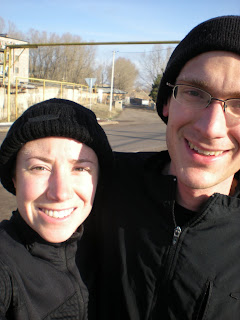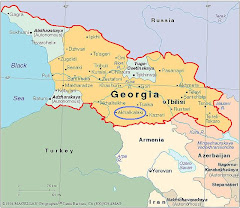One of the projects I have been working on here in Georgia is a fitness club for girls and women in my town. There aren’t really a lot of opportunities for females to play sports or run around and the fairly conservative culture frowns upon such actions, especially if undertaken solo. Interestingly, most folks here say the culture has gotten much more conservative since the end of the Soviet Union, a reactionary “return to our roots” that has seen women lose opportunities and rights. Soviet women were expected to play sports and study science and become engineers and doctors. Nowadays, though, it’s like being back in 1950s America (or so it seems to me).
Today's group

Even just being outside after dark alone is a big no-no for the XXs, and a woman walking alone through town will be talked about. So even though lots of ladies have been dying for something to do, it’s easier to go with the flow in this small town than to go against the grain. Women tend to spend their time doing housework (no small task), watching after children, working (due to high unemployment in the city, many women are the main breadwinners in the family), visiting with neighbors and generally staying close to home. Young women and girls get indoctrinated into these roles pretty early as well, although you will see groups of young women walking together in the park into the evening, and girls will play a modified version of “volleyball” or ride bikes when the weather is nice.
There aren’t many organized activities here for girls, though. There are some sports teams and clubs and classes for boys and young men, on the other hand. Akhalkalaki has a fairly nice gym that was built by the federal government not long ago. Although this gym is focused on boxing, it has two basketball hoops and plenty of space for other activities.
The Akhalkalaki Sports Complex

My friend, Marianna, and I, after talking about this imbalance, started planning for and working on pulling this club together. In October we talked with the manager of the gym, and learned that, since it’s a federal construction, we could use the space for free. We secured a time slot—Tuesdays and Thursdays from 6:00pm-8:00pm and Saturdays from 2:00pm-4:00pm. Then all we had to do was get a group of girls together to exercise.
Some running (but that's not all we do!)

It sounded like that would be the easy part. But breaking cultural norms and asking girls and women to leave their houses in the evening, to try something new, and to put themselves in a position where others could gossip about them were difficult things to overcome. Marianna was able to help me navigate these cultural differences, though, and strong-armed a small group of her friends, relatives and students to come. She came up with the brilliant plan that we should meet 30 minutes early and then go door to door to pick up each girl and walk together to the club. That way, no one had to walk alone at night.
Jump!

We started off slowly, first meeting in early November. A solid group of about 5-7 women came from the beginning. Then, in January, Marianna suggested some strategies to build a bigger group. We bought an ad on the local TV channel for a week, advertising our club. More and more people started to hear about the group and get interested. The local news came and interviewed Marianna and me and played a 10-minute segment about the group. In short, we’ve started to grow.
Doing some toe touches

We now regularly have between 10 and 25 girls and women who come to the club, between the ages of 12 and 55. Everyone seems to really enjoy it and it’s gotten easier to get people to meet at the gym itself (they tend to meet up in clusters that live near one another and walk together). This has been a real community-driven project, and one that so far has required no money (other than the $10 I kicked in to buy the TV ad). I have big hopes that pretty soon the fitness group will start to really be seen by everyone as sustainable and will be continued after I leave in another year and a half.
So what do we do in the fitness club? I usually plan a circuit-based exercise routine that tries to hit all muscle groups while focusing on cardiovascular work, strength training, balance and flexibility. I take bits and pieces of all that I’ve learned from years of competitive sports, running, yoga, gym memberships and watching Biggest Loser like a freak. We have limited resources (a gym and a few mats), so we rely on lots of body weight exercises. Here’s what we did today:
Working to get the form right first

1-Run two laps around the gym, walk two laps
2-Stretches
3-Jump 4 ways: 10 jumping jacks, 10 lateral line jumps, 10 twist jumps (like doing the twist, only jumping), 10 high-knee jumps (jump and bring your knees up as high as you can), followed by 1 walking lap, 2 running laps, 1 walking lap (3 sets of this)
4-Modified pushups-hold in plank (pushup) position for 5 seconds, then lower as close as you can to the floor, then drop to the floor and push yourself up from there. Repeat 5 times. (2 sets)
5-Lying toe touches-lie on your back with your legs straight up, then reach up and touch your left foot with your right hand and return to start, then reach up and touch your right foot with your left hand and return to start (10 touches, 2 sets)
6-4 types of running-giant strides (full court down and back), butt kicks (full court down and back), high knee running (to half court), lunge steps (back from half court) (2 sets)
7-Superman swim-lie on your stomach and lift your arms and legs, keeping them straight, then move them up and down like your swimming (10 seconds) (2 sets)
8-Side planks (10 seconds on each side) (2 sets)
9-Bicep tables-with your hands under your shoulders (hands pointing towards feet) and feet under knees, push yourself up so your belly is flat. Hold for 10 seconds. Then do 5 tricep dips. Push back up to table position and hold another 5 seconds (2 sets)
10-Indian run-run in a line, slowly. The last person in the line has to sprint to the front of the line. As soon as she is in the front, the new last person sprints ahead. (2 laps)
11-Cardio relay-sprint from one sideline to the other, walk back to start, then skip from one sideline to the other, walk back to start, then hop on right leg from sideline to sideline, walk back to start, then skip on the other leg and walk back to start. Follow with walk one lap, run one lap. (2 sets)
12-Run two laps, walk two laps
13-Stretch
We always start and finish with running 2 laps, walking 2 laps and stretching. By keeping the exercises short and doing 2-3 sets of them before moving on to something new, it stays interesting and, while challenging, isn’t too much for anyone. You might see that there is a lot of running when all added up (I figure it’s about 2/3 of a mile of running and about the same of walking each session), but since it’s broken up it never seems like too much for anyone. And I always try to give modified versions of exercises that increase or decrease the difficulty (so people can walk instead of running, or do only every other repetition of an exercise or hold their legs differently to make something easier or harder). My only rules are that we should have fun, stop and tell me if something hurts and not to sit down during the club.
After we finish (we usually work out for about an hour or 70 minutes), most of the girls want to play “basketball” for a few additional minutes, and some of the older participants ask me to show them additional stretches or exercises. I use a lot of yoga poses for these smaller groups, since it’s easier to keep an eye on their form and make sure no one is doing something that will throw out their back or cause any damage.
All in all, the fitness club has become one of the highlights of my week and the most fun thing I do!



























